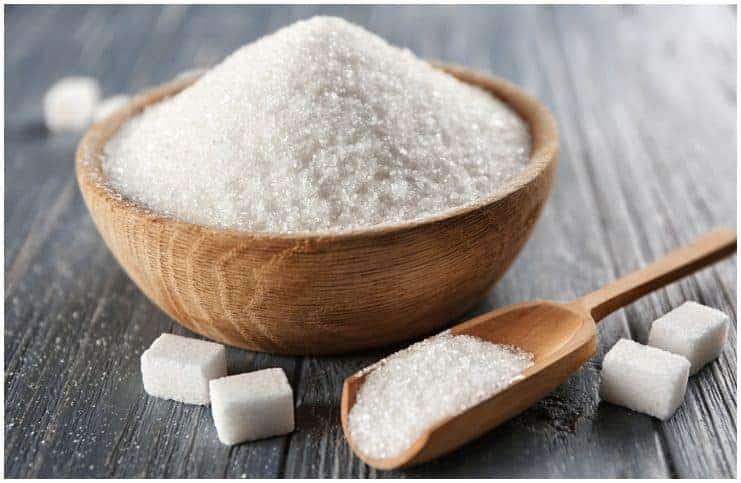Dextrose vs Maltodextrin – detailed comparison:
Dextrose
It is a simple carbohydrate or monosaccharide that is produced when starchy plants – mainly corn (and less commonly rice or wheat) – are broken down into monosaccharides using enzymes.
Dextrose is also the form of glucose in the blood and is used as the main form of energy from carbohydrates in the human body.
Dextrose is commonly used by athletes and bodybuilders to replace glycogen in muscle cells that are lost during training, and to induce an insulin spike.
It is also used to make several intravenous mixtures or preparations, that are available only at a medical facility or hospital.
It is added to some single-serve artificial sweetener packets as a filler. Dextrose is also found in desserts like puddings and cakes, snack foods like crackers and pretzels, and baking products like frostings and cake mixes.
Benefits
Rapid Absorption
It is absorbed more quickly than whole foods, which can be important for post-workout recovery.
People with hypoglycemia (chronically low blood sugar) or diabetes may also carry dextrose tablets or gel in case their blood sugar (glucose) gets too low.
No Fat, Cholesterol, Sodium
It does not contain sodium. Excess sodium (the main ingredient in table salt) in the human body can increase your chances of developing high blood pressure. It can also result in water retention and a subsequent bloated appearance.
Moreover, dextrose has no cholesterol. It also does not contain fat.
Side Effects
Because it is an extremely fast-digesting simple sugar, dextrose raises blood glucose (sugar) levels quickly, leading to a rapid spike in insulin (a hormone that regulates the level of sugar in the blood) into the bloodstream.
Most dextrose is made from genetically modified corn, using genetically modified organism enzymes. Therefore, individuals who are concerned about avoiding genetically modified organisms will want to look for organic or non-genetically modified organisms on the label of any products which contain dextrose.
READ MORE: Toradol vs Ibuprofen 800
Maltodextrin
It is a powdery substance that is produced through a chemical process called hydrolysis that converts the starch in cornstarch into sugar. Additionally, it can be produced from other sources, including potato, corn, wheat, or rice.
According to the U.S. Food and Drug Administration, maltodextrin is listed as a Generally Recognized as Safe (GRAS) food additive.
Maltodextrin got a higher glycemic index than table sugar, ranging somewhere between 106 and 136, which means it can increase blood sugar very fast. Table sugar has a glycemic index of 63.
The following foods often contain this food additive:
- soups;
- candy;
- prepackaged chips;
- chocolate;
- low-calorie foods;
- commercially baked goods;
- bottled and canned beverages;
- sugar substitutes;
- beer;
- pudding;
- weight training supplements;
- pie fillings;
- sauces;
- salad dressings;
- seasoning blends;
- nutritional drinks;
- granola;
- canned fruit.
Due to its ability to quickly increase blood sugar (glucose) levels when they are low, maltodextrin is prescribed as a part of regular treatment for people with hypoglycemia (low blood sugar).
READ MORE: Nasalcrom vs Flonase
Benefits
It is used to improve endurance, enabling athletes to keep going during a longer cardio workout session.
Side Effects
While most maltodextrin is considered gluten-free, it may be manufactured from wheat, hence, people with gluten sensitivity may experience negative effects after consuming foods and drinks with this food additive.
Allergic Reactions
Allergic reactions to this food additive have been reported, and the symptoms may include:
- diarrhea;
- rash;
- vomiting;
- nausea.
Blood Sugar Spike
It can cause a spike in your blood sugar levels. Therefore, individuals with diabetes or prediabetes should avoid food and drinks containing this food additive.
GMO
Buy organic, since most corn is genetically modified organism corn.
READ MORE: Aleve PM vs Tylenol PM
Dextrose vs Maltodextrin – Which Is The Best Post-Workout Carb?
The main reason to consume carbohydrates post-workout is to replenish the muscle glycogen which you burned during your workout.
Carbs ingestion after a tough workout session will also get you on the road to recovery faster, specifically simple carbohydrates that digest quickly in the body.
In addition, the timing of your post-workout meal matters. It is recommended to eat within 45 minutes of finishing your physical exercise session due to the fact that your body’s capacity to rebuild protein and glycogen is increased after your workout.
Actually, it is considered that the delay of carbohydrate intake by 120 minutes after a workout session may lead to about 50 percent lower rates of glycogen synthesis.
Regarding maltodextrin and dextrose, maltodextrin features a string of glucose molecules, that can be easily broken down, while dextrose is a simpler form of sugar that your body doesn’t need to break down.
In conclusion, both carbohydrates are readily available to you after a workout to replenish your lost glycogen as well as provide an insulin surge you need to boost muscle growth. However, dextrose is absorbed faster by the body than maltodextrin.
In addition, dextrose produced from corn is considered safe and reasonably priced. Furthermore, you can easily take a dextrose supplement on the go by combing it with your protein shake.
READ THIS NEXT: Nabumetone vs Ibuprofen
References https://www.sciencedirect.com/topics/chemical-engineering/dextrose http://journals.plos.org/plosone/article?id=10.1371/journal.pone.0101789
